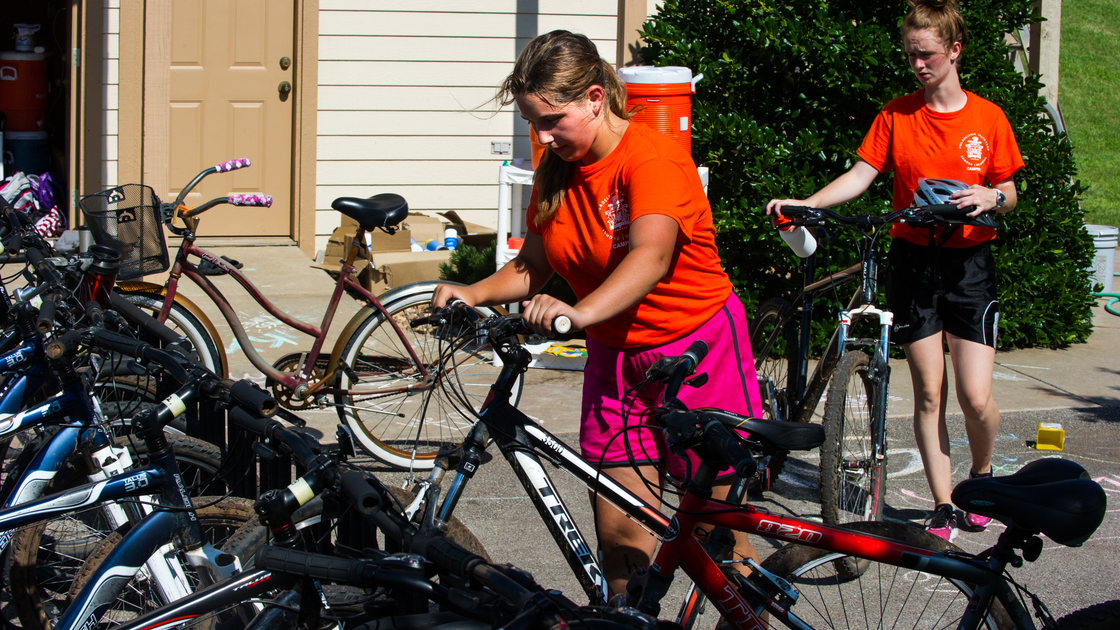As a fluorescent orange dorm walked toward us at the cycling station, I squinted to make sure it was the one I was looking for. Yes, that was 1G, but they were missing their enthusiastic Aussie counselor Danielle Underwood. There was a man at the head of the line instead. My confusion evaporated as they moved closer. Head cycling instructor Nick Irwin, assistant instructor Sarah Kimes and I realized that it was counselor swap day, so Daryle Hochstetler of 1B was leading 1G for the day. As the girls and Mr. Hochstetler neared the cycling tower, they yelled, “Hello Uncle Irwin and cycling staff!”
The girls filled their water bottles, changed their shoes, grabbed helmets, and chose their bicycles for the class. Mr. Irwin had to lower some of the bike seats since some of the more vertically challenged girls had difficulty getting on the bikes with tall seats. Then the campers attentively listened to Mr. Irwin as he re-explained the cycling long course. This was 1G’s second cycling class, but the girls hadn’t had a cycling class since the first day of camp two weeks previous. To avoid having lost campers wandering all over campus, their cycling instructor detailed some of the trickier parts of the course. Contrary to the usual cycling class routine, he took the girls through the course once himself so no one would get lost.
And then they departed in a flurry of orange and red shirts. I watched them through the trees as they cycled up the road and disappeared from my view. I would have gone with them on a spare bicycle to get first-hand information from the actual cycling part of cycling class, but unfortunately, there were no spare bikes. I did not think my own vintage velocipede would survive the course, so I stayed behind. The sounds of flag football chants kept me company as I waited for the return of the traffic cones.
Finally, the cyclists began to trickle in after Mr. Irwin. Most of the girls were unscathed from the course, but somehow Selah had managed to get two of the muddiest legs I have ever seen. She wasn’t even sure how it happened. Perhaps the mud leaped onto her from the ground.
After a water break, we all got on our bicycles and traveled to the short course, a series of real orange traffic cones that the cyclists had to maneuver around. If a cyclist lost her balance and put her foot down onto the asphalt, her turn was over. This added dimension of difficulty kept 10 of the 11 assembled girls (the 12th was in sick bay) from finishing the course. Only Sarah, who had two swollen and somewhat sprained ankles, was able to make it through the entire course—quite a feat, considering that ankles are rather essential for pedaling a bike.
The girls pedaled back to the tower to grab another drink and then lined up at a pink chalk line to cycle the long course for time. Miss Kimes staggered the girls so that only one or two would leave at the same time, making it easier for her to write down their finishing times. The girls averaged about nine minutes apiece for the long course. After finishing the course, the girls rehydrated, sat in the shade, cheered on their fellow cyclists as they finished the course, and swapped war stories. Emily, the last 1G cyclist, said that there had been a rattlesnake on the course. Perhaps not cycling with them was a wise decision.
1G circled up to decide on a cheer. Their assistant counselor, Brandi Davis, told the girls that Mr. Irwin loves puns, so they cheered, “Thanks for spinning our spokes with us, cycling staff!”
The cycling staff and I replied with a cheer that was my personal invention: “Thanks for gearing us up for tonight, 1G!”
The girls laughed and then hurried to gather their belongings. Then they headed back to their dorm to prepare for that night’s activity: faculty home visits.
